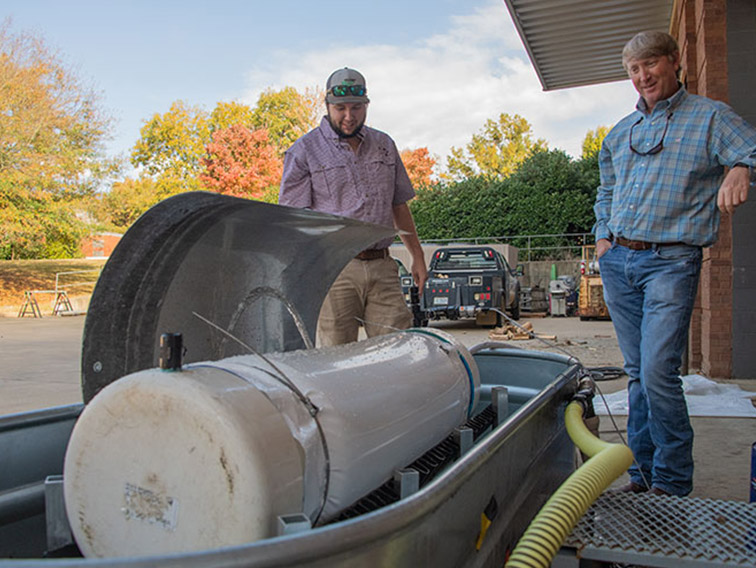The information presented on this page may be dated. It may refer to situations which have changed or people who are no longer affiliated with the university. It is archived as part of Mississippi State University's history.
When asked about his graduate student Dru Carey, Dr. Wes Lowe beamed with pride. "The sky's the limit for Dru," bragged Lowe, "With the attitude he has, he can do anything he wants."
Lowe, assistant professor in the Department of Agricultural and Biological Engineering and MAFES scientist, knows the Olive Branch native well. They first met when Carey was an undergraduate student and have worked closely since. Lowe recognized that Carey had a strong work ethic and an even stronger character so when the time came for graduate research, he was the perfect candidate.
"When we pulled our team together, Dru was just a natural fit," Lowe said. "He has a unique skill set in the fact that he is very gifted academically, but also very practical and applied. He understands production agriculture."
Carey's original plan for his graduate research was to create an automatic hole punch mechanism in poly-pipe rollers, a tool that dispenses the pipe. As he began planning for this project, Carey realized how little information was available on what poly-pipe thickness one should use at varying water pressures.
Carey's research takes it back to the basics and examines the fundamentals of lay-flat irrigation tubing, commonly known as poly-pipe. Poly-pipe is made of polyethylene plastic and used as a supplemental irrigation system for row crops. Farmers will line poly-pipe across row crop fields and puncture the material to allow for water to flow out and irrigate the crops. However, many farmers face issues with frequent poly-pipe bursts due to the lack of poly-pipe information. Carey's research will create a user guide to assist farmers in selecting the correct poly-pipe to prevent failures.
To conduct this research, Carey and his team prepared poly-pipe sections of various thickness with single-punched holes. They then ran water at a normal operating pressure of 90 percent and ran again at 125 percent to see how the pipe reacts to the over pressurization.
"So far, I've seen a three to five percent water waste from carrying the pipe overpressure," Carey said of the data he has available. "This doesn't seem like much, but on a well that puts out 2,000 gallons of water a minute over eight hours, that's a large amount of water that is not really being distributed in the way it should."
Carey will conclude his research in January 2022 and plans to graduate with a master's in agricultural and biological engineering in August 2022. After graduation, Carey hopes to continue his education by pursuing a doctoral degree. If he is accepted into the doctoral program at Mississippi State, Carey hopes to use his graduate research to create an automatic hole punch mechanism for poly-pipe rollers.
"One of the biggest things I'm excited about is that after I finish this work, it will go into an Extension publication and inform farmers on irrigation and pressurization," Carey said.
In addition to his own research, Carey is the first to lend a helping hand to other students conducting research in his department.
"Dru's truly an outstanding graduate student," Lowe said. "He does way more than just his research. He coordinates several different research projects just because he has that drive and initiative and wants to be involved and learn about all of them."
This research is funded by the Mississippi Soybean Promotion Board. In addition to Carey and Lowe, the research team includes Dr. Daniel Chesser, assistant professor in agricultural and biological engineering; Dr. Drew Gholson, assistant professor in plant and soil sciences and coordinator of the National Center for Alluvial Aquifer Research; and undergraduate assistants Dexter Blissard, James Roberts, Hunter Brazeal, and Logan Littlejohn.

